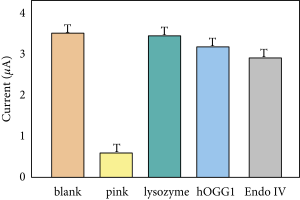Remember the paper that made the rounds on Twitter after readers discovered that the error bars in one of its figures were really just capital Ts?
Well, it’s now been retracted, with the notice citing “concerns about the article’s scientific reliability.”
Error bars are supposed to express the statistical uncertainty of a measurement depicted in a graph, but the ones in this paper appeared to be capital letter Ts pasted on for looks.
As we mentioned in a previous post, the error bars were just the most obvious strange thing about the paper, “Monitoring of Sports Health Indicators Based on Wearable Nanobiosensors,” which was published earlier this year in a special issue of the Hindawi journal Advances in Materials Science and Engineering.
The journal published an expression of concern for the paper on December 1, days after the error bars attracted attention that led to readers finding other oddities in the article, saying that the publisher “is investigating these concerns and will revisit this article with any necessary post-publication amendments.”
On December 19, the journal published the following retraction notice, which acknowledged that one of the issues a reader spotted was its own fault:
Advances in Materials Science and Engineering has retracted the article titled “Monitoring of Sports Health Indicators Based on Wearable Nanobiosensors” [1]. Since publication, readers have raised concerns that the error bars in Figure 9 appear to be the letter “T.” Moreover, it has been noted that the authors state that “no datasets were generated or analyzed during the current study” which is contradictory to the study described. This therefore raises questions about the reliability of the underlying data and the article’s conclusions.
The article includes several instances where different sections are clearly unrelated. For instance, as the survey collecting information on the fitness activity of elderly people in Jilin province is not well described, it is unclear how it relates to the research on nanomaterials and wearable biosensors. Furthermore, several references cited do not support the article and have been found to be irrelevant. Of note, in addition to not being relevant to the corresponding text, reference [16] was retracted prior to the submission of the current article due to containing nonsensical content [2].
Finally, we would like also to acknowledge that a reader raised concerns that an incorrect notation was used in Equations (13) and (14); however, upon review, this appears to be an error made during the production process. The Publisher apologizes for this error.
The authors did not respond to our summary of the concerns nor our request to provide the original data and ethics approval documentation. After careful assessment of the concerns raised, we have concerns about the article’s scientific reliability and are therefore retracting.
The authors agree to the retraction and the notice.
The article’s lead author, Binghong Liu of Kunsan National University in Korea, did not reply to our request for comment for our original article.
Hat tip: Cheshire
Like Retraction Watch? You can make a tax-deductible contribution to support our work, follow us on Twitter, like us on Facebook, add us to your RSS reader, or subscribe to our daily digest. If you find a retraction that’s not in our database, you can let us know here. For comments or feedback, email us at [email protected].

“The authors did not respond […]. The authors agree to the retraction and the notice.”
I wonder how that exchange went.
Something along the lines “oops, caught red-handed but no buzz plz”
It’s time to retract the retraction post.
This sentence in the retraction notice makes no sense: “Of note, in addition to not being relevant to the corresponding text, reference [16] was retracted prior to the submission of the current article due to containing nonsensical content [2].” How does one retract prior to submission? How did anyone know about reference 16 if it was removeed prior to submission? The whole episode appears to be a joke or a test of a Journal’s sanity, partly confirmed by this odd sentence.
Albert, you misunderstand. Reference [16] was in the published version of the focal article, not removed prior to submission. But the article to which reference [16] refers was retracted prior to the submission of the focal article. It seems no great sin to be unaware that a cited article had been retracted (unless it was written by the same authors that cited it). But the reason for the cited article’s retraction was that it contained non-sensical content, which does imply that citing it was not appropriate in any case.
And what about referees? Who does retract them?
One benefit of paying referees would be that dropping someone as a referee due to bad-quality work would actually be a deterrent: as it stands it’s almost a reward. Reviewing is hard work and while Publons is trying, is really not rewarded proportional to how hard it is (if you do it well, anyway).
> One benefit of paying referees would be…
The problem is, this paper has likely never had a chance to be seen by a decent referee. Who wouldn’t bother rejecting it in 15 minutes rather than declining the offer, no matter for payment or not.
Should I also elaborate that some referees are part of the papermilling service? And that publishers won’t ever hesitate paying them? And who wins and loses from the eventual increase of APC / subscription costs that is certain to follow?
Agree with you Alex. There are publishers and Authors wont ever hesitate paying (bribing) them.
is there not a “Bring to the Front” option?
Most graphics allow this & it is should be a no-brainer for in graphing software.
At least it pretended to have error bars! There are a lot of papers that just graph dots or arrows with no attempt to estimate the uncertainty. I wish the journals would have a look at these papers too.
https://pubpeer.com/publications/9D7247C13B6A0ACA3E812D4DAECB0B#7
https://pubpeer.com/publications/37B87CAC48DE4BC98AD40E00330143#58
You get what you pay for when you choose discount paper mills!